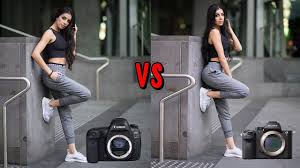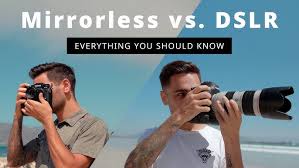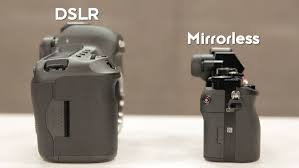
What is a Mirrorless Camera?
A mirrorless camera is a type of digital camera that does not use a mirror mechanism to reflect light through an optical viewfinder, unlike a traditional DSLR. Instead, it captures images directly through its image sensor, offering a more compact and lightweight design. Mirrorless cameras rely on the electronic viewfinder (EVF) or the camera’s LCD screen to compose shots. They offer fast autofocus, high-quality video capabilities, and interchangeable lenses, making them popular among both professional photographers and content creators. These cameras offer excellent performance in a smaller, more portable package than DSLRs.

What is a DSLR Camera?
A DSLR (digital single-lens reflex) camera is a type of digital camera that uses a mirror mechanism to reflect light from the lens into an optical viewfinder. This allows photographers to see what the lens actually sees, providing a real-time, clear view of the scene. DSLRs are known for their high image quality, large sensors, and interchangeable lenses, making them popular among professional photographers and enthusiasts. They offer advanced features such as manual control over settings such as exposure and focus, as well as the ability to capture high-resolution photos and videos. Despite being larger than mirrorless cameras, DSLRs are highly versatile and are widely used for both still photography and video production.
Key Features of DSLR Cameras:
- Mirror mechanism: Uses a mirror to reflect light from the lens into an optical viewfinder, allowing photographers to see what the lens sees in real time.
- Interchangeable lenses: Provides the flexibility to change lenses for different types of photography, such as wide-angle, macro or telephoto lenses.
- Larger image sensor: DSLR cameras typically have larger image sensors than compact cameras, resulting in better image quality, especially in low light.
- Optical viewfinder: Provides a direct view through the lens without delay, giving a more natural, real-time preview of the scene.
- Manual control: DSLR cameras offer full manual control over settings such as shutter speed, aperture and ISO, allowing photographers to fine-tune their exposure.

COMPARE
Here’s a comparison table between Mirrorless and DSLR cameras:
| Feature | Mirrorless Camera | DSLR Camera |
|---|---|---|
| Size & Weight | More compact and lightweight | Larger and heavier due to the mirror mechanism |
| Viewfinder | Electronic Viewfinder (EVF) or LCD screen | Optical Viewfinder (OVF) through a mirror |
| Autofocus Speed | Faster and more accurate in live view/video | Faster in still photography due to phase detection |
| Battery Life | Shorter battery life due to EVF and LCD screen | Longer battery life due to optical viewfinder |
| Lens Selection | Fewer lens options (growing selection) | Wide range of lenses due to longer market presence |
| Image Quality | Excellent, but can be slightly affected by EVF | Generally superior image quality, especially in low light |
| Video Recording | Excellent video performance (often 4K) | Good video capabilities, but may lack advanced features |
| Real-Time Preview | Provides a live view of exposure, depth of field, etc. | Optical viewfinder provides no real-time preview |
| Durability | Generally less rugged and weather-sealed | Often built with more rugged, weather-sealed bodies |
| Price | Generally more affordable, with some high-end models | Often more expensive, especially professional-grade models |
| Focus Mechanism | Contrast detection or hybrid autofocus (faster in live view/video) | Phase detection (faster in traditional photography) |
| Portability | Better for travel and portability | Bulkier and less travel-friendly |
This table provides a clear comparison of the two camera types based on various factors like size, autofocus, and image quality, helping you understand the key differences between mirrorless and DSLR cameras.
